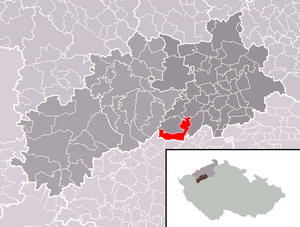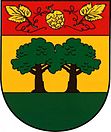Domoušice
| Domoušice | ||||
|---|---|---|---|---|
|
||||
| Basic data | ||||
| State : |
|
|||
| Region : | Ústecký kraj | |||
| District : | Louny | |||
| Area : | 1,527.0438 ha | |||
| Geographic location : | 50 ° 14 ' N , 13 ° 44' E | |||
| Height: | 415 m nm | |||
| Residents : | 636 (Jan. 1, 2019) | |||
| Postal code : | 439 68 - 440 01 | |||
| License plate : | U | |||
| traffic | ||||
| Street: | Jimlín - Mutějovice | |||
| Railway connection: | Rakovník – Louny | |||
| structure | ||||
| Status: | local community | |||
| Districts: | 2 | |||
| administration | ||||
| Mayor : | Zdeněk Kutner (as of: 2013) | |||
| Address: | Domoušice 107 439 68 Domoušice |
|||
| Municipality number: | 566152 | |||
| Website : | www.domousice.cz | |||
| Location of Domoušice in the Louny district | ||||

|
||||
Domoušice (German Domauschitz ) is a municipality in the Czech Republic . It is located 17 kilometers southeast of Žatec and belongs to the Okres Louny .
geography
Domoušice is located on a hill to the right above the Hasina valley in the Džbán hill country . The village is located in the Džbán nature reserve. To the north rises the Červený vrch (400 m), in the northeast the Podhora (459 m), east the Číhadlo (482 m), in the south the Džbán (536 m), southwest the Zadní Rovina (524 m), in the west the Rovina , the Pískový vrch (526 m) and the Špičák (490 m) and northwest of the Pravda (484 m). The Rakovník – Louny railway runs through the village .
Neighboring towns are Markvarec and Konětopy in the north, Solopysky, Horní Ročov and Dolní Ročov in the Northeast, Smilovice , boron, Milý and Pochvalov the east, Dučice, Kalivody , Kroučová and Třeboc the southeast, Filipov and Lhota pod Džbánem in the south, Perun, Mutějovice , Milostín and Kounov in the south-west, Na Rovinách, Deštnice and Nečemice in the west and Lhota, Výhledy, Kozlov, Nový Svět, Třeskonice and Pnětluky in the north-west.
history
The municipality was already settled in the early days. On the Rovina there was a fortification from the late Hallstatt period between 560 and 460 BC. Chr.
Domoušice was probably laid out at the beginning of the 14th century in the royal forests of Džbán under Slavic law. It is believed that the village was originally called Tomášice and was named after its founder, a royal chamberlain, Tomáš.
Domoušice was first mentioned in a document on November 4, 1325, when King John of Luxembourg granted the knight Chwal and his son Dietrich the emphyteutic suspension of the village under German law. At the same time the king granted them the settlement of a baker, butcher, cobbler, blacksmith and miller, the establishment of a tavern, the appointment of a village judge and the application of Nesuchin law. A little later the deputy epleban was moved from Velhota to Domoušice. Since the 1370s, the Church of St. Martin is a branch church of the Kounov parish . After the death of Dietrich von Domoušice, the village fell to the Insula monastery . In 1373 the Benedictine Covent issued various taxes to the village and also granted it Rakonitz rights. After the destruction of the Insula monastery by the Hussites , King Sigismund seized the property and pledged it to various lords for service in the fight against the insurgents. The population became Protestant at that time. The last pledge holder was Heinrich Kolowrat -Žehrovský, from whom the Bohemian crown redeemed the pledge in 1460. Georg von Birka and Nassiedel ( Jiří Bírka z Násilé ) later acquired the estate, followed by his son Wenzel. After the property was pledged to the town of Louny , Domoušice had its old privileges confirmed in 1534, particularly German law. After Emperor Rudolf II had built the St. Elisabeth Hospital in Prague's New Town in 1599 , he left Domoušice to the New Town Council for the benefit of the hospital, which transferred the property to the St. Apollinaris deanery . After the Battle of the White Mountain , the Protestant pastor was expelled and the parish was administered by the Launer Dean due to the lack of Catholic clergy . In 1627 the judges 'estate was converted into a farm together with some of the farms that had fallen desolate in the Thirty Years' War. In the following year, the property passed from the property of the Deanery of St. Apollinaris to the Metropolitan Chapter of St. Vitus at Prague Castle , which designated the property as the beneficiary of the oldest canons. As a result, the Prague canon and dean of St. Apollinaris Elias Kolbius von Kolumberg became the owner of Domoušice, followed by Cyprian Petrides von Steinfeld, who leased the farm to Tomáš Písařovic. After the end of the war, the administration of the parish Domoušice was transferred to the Augustinian monastery Unter-Rotschow . At this time, the robot duties increased. In the berní rula from 1654, 13 farmers and seven chalupners are listed for Domoušice . The following owners included the canons Daniel Hesselius von Kamsberg, Zetwinger von Zetwinberg, from 1681 Georg Kriegelstein and from 1686 Thomas Johann Becker. Because of the high level of forced labor, rebellions broke out in the late 1670s. Emperor Leopold I therefore ordered relief in 1680 and reduced the robot to three days a week. The first news about a teacher in Domoušice comes from 1697, the lessons took place in rented rooms. On March 7, 1754, the cathedral chapter sold the remote and unprofitable Domoušice estate to the cathedral capital, Johann Andreas Kneisl. At that time, Domoušice consisted of 14 full-hoppers and twelve half-hunters. Johann Andreas Kneisl had the church expanded. From him his nephew, the Appellationsrat Johann Augustin von Kneisl inherited the estate. This broke the imperial robot patents and increased the labor, in the period from 1770 to 1771 there were riots in Domoušice because of the high loads. Due to economic difficulties, Johann Augustin Kneisl sold the estate to Wenzel Johann Paul in 1783. Paul had a school built in Domoušice, in which the children from Solopysky were also taught. On the slope south of the church, where old Tomášice probably stood, he had the Philippsthal settlement built in 1784. When house numbering was introduced, Domoušice consisted of 42 houses, including an inn, a smithy, a mill and a manorial hunter's house. Around 1790 the son of Wenzel Johann Paul, Leopold Paul, inherited the estate. He sold it to Karl Prückner in 1799. In 1802 Jakob Wimmer von Wimmersberg bought the estate. In December of the same year he sold it to Joseph II zu Schwarzenberg , who added it to his rule Zittolieb with Diwitz. In 1833 Johann Adolf II. Zu Schwarzenberg inherited the property. In 1836 a parish was established in Domauschitz.
In 1844 the landed estate Domauschitz comprised a usable area of 975 yoke 245 square fathoms. 593 Czech-speaking people lived on its territory, including three Jewish families. Only the villages Domauschitz and Philippsthal belonged to Gut Domauschitz.
The village of Domauschitz consisted of 50 houses with 442 inhabitants, including three Jewish families. Under the patronage of the authorities were the parish church of St. Martin, the parish administration and the school. There was also an official castle in the village, a dominical farm with sheep, a mill and an inn. Aside, on the plateau of the same name, was the Rowina Meierhof with a Dominikal house. Domauschitz was the pastor for Philippsthal ( Filipov ). The residents lived from growing fruit, hops and potatoes, the heavy red Lettenboden was productive despite the cold location. In addition, plans were broken. Due to the increased number of students, the school was expanded in 1844. Until the middle of the 19th century, Domauschitz remained subject to the allodial rule Zitolib and the Domauschitz estate.
After the abolition of patrimonial Domaušice / Domauschitz formed from 1850 with the district Filipov / Philippsthal a political municipality in the district and judicial district of Laun. In 1869 the village had 779 inhabitants. In 1874 the two-class and in 1881 the three-class instruction was started. In 1883 a new school building was built. At the end of the 19th century the place was called Domousice , the current form of the name Domoušice prevailed at the beginning of the 20th century. In 1904, the Rakonitz – Laun railway began operating on the Rakonitz – Laun line . At the beginning of the 20th century, a new rectory and numerous new residential buildings were also built. At the 1921 census, Domoušice had 1039 inhabitants, which was also the highest population in the history of the place. During this time Filipov and Domoušice grew together. After 1950 Filipov lost its status as a district. In 1961, 745 people lived in Domoušice. At the beginning of 1981 Solopysky was incorporated. The district Domoušice had 450 inhabitants in 2001. Domoušice is a hop growing place.
Community structure
The municipality Domoušice consists of the districts Domoušice ( Domauschitz ) and Solopysky ( Solopisk ). The municipality is divided into the cadastral districts of Domoušice and Solopysky u Loun. The settlement Filipov ( Philippsthal ) and the one-layer Na Rovinách ( Rowina ) also belong to Domoušice .
Attractions
- Baroque Church of St. Martin in Filipov, built in 1754 under Andreas Kneisl on an elevated point southeast of Domoušice
- The stone bell tower and two chapels in the Filipov cemetery, built in the 18th century
- Domoušice Castle, built in 1714 for the canons. From 1802 to 1924 it belonged to the Schwarzenberg family, after which it was the seat of a state forestry office. Today the well-preserved castle is privately owned and serves as a residence.
- Chapel of St. Anna in the village square of Domoušice, built in 1764
- Castle stables Domoušice or Rovina on the plaque of the same name west of Domoušice. From the late Hallstatt fortifications from the period between 560 and 460 BC. Remains of the wall and the moat have been preserved. On the Zadní Rovina there are also the rows of stones by Kounov .
- Pravda castle ruins from the middle of the 15th century, northwest of the village on the ridge of the same name
- Džbán castle ruins , also known as Čbán or Držemberk, on a spur of the Džbán plateau south of Domoušice, they were probably destroyed in 1318 during the battles between Wilhelm Zajíc von Waldeck and King John of Luxembourg between Žatec and Rakovník .
- Ferrous mineral spring in Solopysky
- Chapel in Solopysky
Sons and daughters of the church
- Josef J. Pihert (1845–1911), composer
- Václav Bergman (1915-2003), fighter pilot, he was the commander of the 310th Czechoslovak fighter squadron of the RAF (1942) and the 313th Czechoslovakian fighter squadron of the RAF (1944)
Individual evidence
- ↑ http://www.uir.cz/obec/566152/Domousice
- ↑ Český statistický úřad - The population of the Czech municipalities as of January 1, 2019 (PDF; 7.4 MiB)
- ↑ Johann Gottfried Sommer The Kingdom of Bohemia, Vol. 14 Saatzer Kreis, 1846, pp. 39–45
- ↑ Johann Gottfried Sommer The Kingdom of Bohemia, Vol. 14 Saatzer Kreis, 1846, p. 45
- ↑ http://www.uir.cz/casti-obce-obec/566152/Obec-Domousice
- ↑ http://www.uir.cz/katastralni-uzemi-obec/566152/Obec-Domousice
Web links


